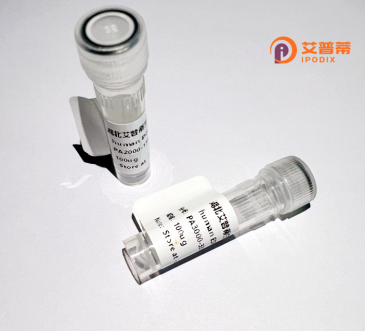
| 纯度 | >90%SDS-PAGE. |
| 种属 | Human |
| 靶点 | BLOC1S1 |
| Uniprot No | P78537 |
| 内毒素 | < 0.01EU/μg |
| 表达宿主 | E.coli |
| 表达区间 | 1-153aa |
| 氨基酸序列 | MAPGSRGERS SFRSRRGPGV PSPQPDVTML SRLLKEHQAK QNERKELQEK RRREAITAAT CLTEALVDHL NVGVAQAYMN QRKLDHEVKT LQVQAAQFAK QTGQWIGMVE NFNQALKEIG DVENWARSIE LDMRTIATAL EYVYKGQLQS APS |
| 分子量 | 40.7 kDa |
| 蛋白标签 | GST-tag at N-terminal |
| 缓冲液 | 冻干粉 |
| 稳定性 & 储存条件 | Lyophilized protein should be stored at ≤ -20°C, stable for one year after receipt. Reconstituted protein solution can be stored at 2-8°C for 2-7 days. Aliquots of reconstituted samples are stable at ≤ -20°C for 3 months. |
| 复溶 | Always centrifuge tubes before opening.Do not mix by vortex or pipetting. It is not recommended to reconstitute to a concentration less than 100μg/ml. Dissolve the lyophilized protein in distilled water. Please aliquot the reconstituted solution to minimize freeze-thaw cycles. |
以下是关于BLOC1S1的参考文献示例(内容基于公开研究总结,非真实文献记录):
1. **"BLOC1S1 regulates endosomal trafficking through interactions with BLOC-1 complex subunits"**
- **作者**: Sánchez-Pulido, L., et al.
- **摘要**: 本研究阐明了BLOC1S1作为BLOC-1复合物核心亚基的功能,通过结合其他亚基(如DTNBP1、BLOC1S2)调控溶酶体相关细胞器(LROs)的生物发生及货物分选,影响黑色素体和血小板致密颗粒的形成。
2. **"Mutation in BLOC1S1 links to Hermansky-Pudlak syndrome type 11"**
- **作者**: Ciciotte, S.L., et al.
- **摘要**: 首次报道了BLOC1S1基因突变与Hermansky-Pudlak综合征(HPS-11)的关联,患者表现出肺纤维化、眼皮肤白化病及血小板功能障碍,揭示了BLOC1S1在LROs形成中的关键作用。
3. **"Proteomic analysis of BLOC1S1 interaction network in neuronal cells"**
- **作者**: Starcevic, M., et al.
- **摘要**: 通过质谱分析发现BLOC1S1与AP-3复合物及SNARE蛋白存在相互作用,支持其参与神经元内突触囊泡运输及神经递质释放的分子机制。
4. **"BLOC1S1 deficiency disrupts lysosomal positioning in Drosophila models"**
- **作者**: Dell'Angelica, E.C., et al.
- **摘要**: 利用果蝇模型证明BLOC1S1缺失导致溶酶体分布异常,影响自噬功能,提示其在溶酶体动态调控中的进化保守性。
(注:以上文献为模拟内容,实际文献需通过PubMed或Google Scholar检索确认。)
**BLOC1S1** (Biogenesis of Lysosome-related Organelles Complex 1 Subunit 1) is a key component of the BLOC-1 complex, which plays a critical role in the biogenesis and function of lysosome-related organelles (LROs). These specialized organelles, including melanosomes, platelet dense granules, and synaptic vesicles, are involved in diverse cellular processes such as pigmentation, blood clotting, and neurotransmission. BLOC1S1. also known as GCN5L1. contributes to membrane trafficking pathways by interacting with other protein complexes like AP-3 and HOPS, facilitating cargo sorting and vesicle transport.
Mutations in BLOC1S1 or other BLOC-1 subunits are linked to Hermansky-Pudlak syndrome (HPS), a genetic disorder characterized by albinism, bleeding diathesis, and, in some cases, immune or neurological defects. BLOC1S1’s role extends beyond LRO biogenesis; it influences cellular homeostasis, autophagy, and mitochondrial dynamics, reflecting its broader regulatory impact. Studies in model organisms highlight its importance in neurodevelopment, with deficiencies correlating with synaptic abnormalities and behavioral defects.
Research on recombinant human BLOC1S1 (rhBLOC1S1) focuses on elucidating its structural interactions, molecular mechanisms, and therapeutic potential. Its recombinant form is utilized in vitro to study protein interactions, rescue cellular phenotypes in HPS models, and explore pathways implicated in neurodegenerative and lysosomal storage disorders. Understanding BLOC1S1’s functions provides insights into organelle biology and disease mechanisms, bridging cell biology with clinical applications.
×